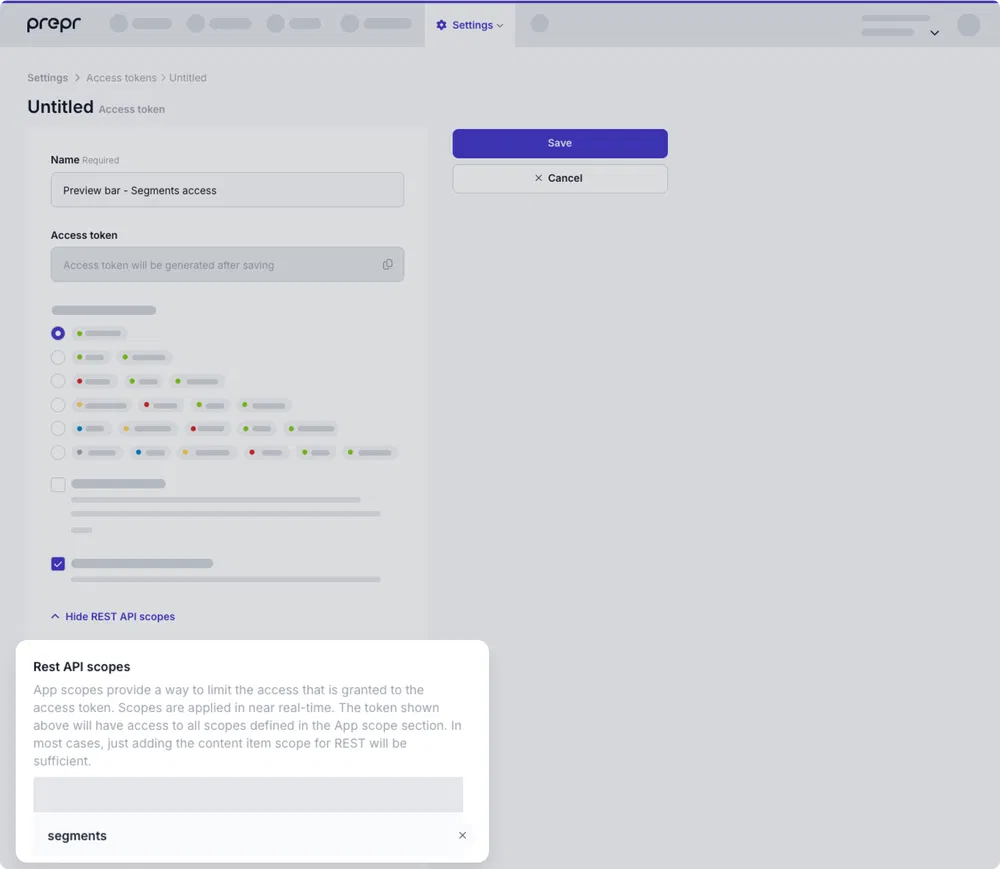The Prepr Next.js package offers some helper functions and the Adaptive Preview Bar component for an easier personalization & A/B testing implementation in your Next.js project.
To install the Prepr Next.js package, run the following command:
npm install @preprio/prepr-nextjsNext, add the PREPR_ENV variable to the .env file. You can enable the Adaptive Preview Bar for a staging environment by setting the value to preview.
PREPR_ENV=previewWhen you're launching your project to production, then set the PREPR_ENV environment variable to production. This way, the Adaptive Preview Bar doesn't get displayed on a live web app.
Next, implement the PreprMiddleware function. Go to your middleware.js or the middleware.ts
file. If you don't have this file, you can create it in the root of your project.
Then add the following code to the middleware.ts file:
import type { NextRequest } from 'next/server'
import { PreprMiddleware } from '@preprio/prepr-nextjs'
export function middleware(request: NextRequest) {
return PreprMiddleware(request)
}Or add the following code to the middleware.js file:
import { PreprMiddleware } from '@preprio/prepr-nextjs'
export function middleware(request) {
return PreprMiddleware(request)
}The PreprMiddleware accepts a request and optional response property and returns a NextRequest object.
This is done so you are able to chain your own middleware to it.
The PreprMiddleware function checks every request if the __prepr_uid cookie is set. If it isn't, the function generates a new UUID and sets it as a cookie. Then it returns a Prepr-Customer-Id header with the value of the __prepr_uid cookie to simplify your personalization and A/B testing implementation.
If the PREPR_ENV environment variable is set to preview, the PreprMiddleware function also checks for searchParams segments and a-b-testing in the URL.
If these searchParams are set, the PreprMiddleware sets the Prepr-Segments and Prepr-AB-Testing headers with the values of the searchParams, and stores its value in a cookie.
To set your API request headers to query adaptive content or A/B testing content, you can call the getPreprHeaders() helper function. It returns an array of headers that you can spread in your fetch call.
See the example code below in the page.tsx file.
import { getClient } from '@/lib/client'
import { GetPageBySlugDocument, GetPageBySlugQuery } from '@/gql/graphql'
import { getPreprHeaders } from '@preprio/prepr-nextjs'
const getData = async () => {
// Fetching the data using Apollo Client
const {data} = await getClient().query < GetPageBySlugQuery > ({
query: GetPageBySlugDocument,
variables: {
slug: '/',
},
context: {
// Call the getPreprHeaders function to get the appropriate headers
headers: getPreprHeaders(),
},
fetchPolicy: 'no-cache',
})
}See the JavaScript example code below in the page.jsfile.
import { getClient } from '@/lib/client'
import { GetPageBySlug } from '@/queries/get-page-by-slug';
import { getPreprHeaders } from '@preprio/prepr-nextjs'
const getData = async () => {
// Fetching the data using Apollo Client
const { data } = await client.query({
query: GetPageBySlug,
variables: {
slug: '/',
},
context: {
// Call the getPreprHeaders function to get the appropriate headers
headers: getPreprHeaders(),
},
fetchPolicy: 'no-cache',
})
return data;
}The preview bar component fetches all segments from the Prepr API. So, you need to give it access to do this as follows:
- In your Prepr environment, go to the Settings → Access tokens page to view all the access tokens.
- Click the Add access token button to create a new access token, give it a name and choose the segments scope like in the image below.
-
Click the Save button and copy the generated Access token.
-
Add a new variable
PREPR_SEGMENTS_ACCESS_TOKENto the.envfile and paste the value you just copied.
PREPR_SEGMENTS_ACCESS_TOKEN=<YOUR-SEGMENTS-ACCESS-TOKEN>To implement the Adaptive Preview Bar component, navigate to your root layout file, this is usually layout.tsx.
Then add the following code to the layout.tsx file:
// Helper function to get all the props for the PreviewBar component (this needs a server component)
import { getPreviewBarProps } from '@preprio/prepr-nextjs'
// Import the PreviewBar component
import { PreprPreviewBar } from '@preprio/prepr-nextjs/components'
// Import the PreviewBar CSS
import '@preprio/prepr-nextjs/dist/components.css'
export default async function RootLayout({children}: {children: React.ReactNode}) {
// Get the props for the PreviewBar component, pass the access token as an argument
const previewBarProps = await getPreviewBarProps(process.env.PREPR_SEGMENTS_ACCESS_TOKEN)
return (
<html>
<head>
{/*...*/}
</head>
<body>
{/* Render the PreviewBar component and spread the previewBarProps */}
<PreprPreviewBar {...previewBarProps} />
{children}
</body>
</html>
)
}Now the Adaptive Preview Bar is rendered on every page of your website. This component shows the segments in a dropdown list and a switch for A and B variants for an A/B test. If you have added the getPreprHeaders() function
to your API calls it automatically updates the segments and A/B testing variants when you select a new segment or variant.
The getPreprUUID() function will return the value of the __prepr_uid cookie. This can be useful if you want to store the __prepr_uid in a cookie or local storage.
Returns the active segment from the Prepr-Segments header.
Returns the active variant from the Prepr-ABTesting header.
Helper function to only get the preview headers.
Helper function that will either return the customer id header or the preview headers depending on the PREPR_ENV environment variable.
Helper function to get the props for the PreviewBar component. Will return the segments and A/B testing variants aswell as an aray of all the segments.
